Lake
Balaton and surroundings
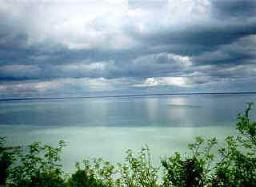
lake balaton
Lake
Balaton and surroundings comprise some of he most beautiful landscapes
in this country. There is an abundance of naturan features, historical
treasures and folk traditions, justifying the popularity of this holiday
region both at home and abroad.
The lake is the largest body of water in Central in Central Europe,
with an area of 590 km2, a leight of 77 km, width of 8-14 km and an
average depth of only 3-4 m. The narrowest point of lake balaton is
beetwen the Tihany peninsula and Szántód, a mere 1,5 km, but it is
also the deepest here by the Tihany well, at 12.4 m.
The color of the lake constantly varies, depending on the time of
day, the cloud cover and the wind, from an angry green, through greenish
blue and blue , to lead grey. The opalescent shades can be attributed
to the mass of plankton and the granis of sand suspended in the water.
Lake Balaton has the ideal features for a holiday spot. The silky,
soft water soon warms up the temperature even reaching 27 celsius
on summer days. The bed of the lake sinks more rapidly on the north
shore than on the south, so it is exelent for swimming and water sports.
The south shore is several hundred meters wide, so even families with
small children can bath safely on this shallow strip. Lake Balaton
is also a favourite spot for yachting, windsurfing and rowing. On
the north shore of the lake pleasant beaches and finally situated
holiday resorts offering a variety of services are to be found. There
are enticing excursions into the pictureesque hill country along the
shore with romantic valleys, evocative villages, and crags crowned
with ruines castles. Other goals for trips are Veszprém, Nagyvázsony
and Keszthely, with abundant historic monuments, Tapolca, famous for
it's lake cave, the Tapolca basin, renowned for it's unusually formed
basalt hills and outstanding wines, Sümeg known for it's castle ,
and Europe's largest warm-water spa lake in Hévíz.
On the south shore, there is a sries of large holiday resorts stretching
from Siófok to Fonyód, visited by crowds of turists in the summer,
so those looking for bathing, bastling society life and entertainment
prefer this section of the shore. After Fonyód resorts with more of
a family atmosphere and to be found. In the territory behind a south
shore, in the inner and Outer Somogy landscapes of the Balaton region,
historic monuments and memorials, lookout towers, mediaeval church
and castle ruins folk art remains, and fine natural features can be
seen. Specially worth seeing are the buffalo reserve at Kápolnapuszta,
the dressable statues of the Virgin Mary in Andocs and Buzsák, and
Krishna Walley, the Hindu religious centre in Somogyváros. In the
LIttle Balaton region, the undisturbed natural beauty and the unique
bird life are fascinating to experience.
GYENESDIÁS
Favourite
holiday spot with a rich past, adjacent to Keszthely. Main attraction:
first-rate beach with excellent services (beach walleyball, giant
slide, water football pitch, high standard service units, free car
park);
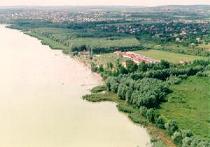
view of gyenesdiás
St
John spring (beginning of Kossuth Str.) alongside, statue of St John
of Nepomuk (1828, Neoclassical); Havas Boldogaszzony church (Darnay
u.; 1893; Italian Neo-renaissance altar), in front, Holy Trinity statue
(1902); Danay type thatched harrow cellar (Nr. 10; 1644; folk monument);
Shepherd's house (Nr. 97; 19. c.; local history collection); St. Ilona
chapel (Hunyadi J. str. ; 1826, Neo-classical);
Great meadow (Faludy str.-Lötéri str.; Excursion spot, woodland gymnastics
area) above. Festetics lookout tower (Varsás hill, following yellow+signs)
Excursion: Great meadow (woodland gymnastics area); Vadlány-lik cave;
Festetics lookout tower; Berzsenyi lookout tower; Büdöskút-puszta
(following yellow signs).
vents: Spring Festival: end of Apr., season opener: Whitsun; Wine
days: 8-11 Jul.; Folklore Festival begining of Aug.; St. Ilona's day
pilgrimade and celebration of St stephen day: 20-22 Aug.; classical
music concerts:every fortnightin hogh season; Vintage merrymaking:
first half of Sept,; bicycle tours.
HÉVÍZ
World
famous spa; Bathing lake (lrgest thermal lake in Europe: 11 ac.; spring
at depth of 43 m; radi-active therapeutic waters; therapeutic mud
several m deep; bath-houses on stilts; unusual plants: water lilies
on the lake, bald cypress on the on the shore, the lake and surroundings
NR); recreation park; Holy pirit church with seven towers (1996-1999:
János Bocskai); Hévíz Pantheon on the wall of the winter baths; Jupiter
altar stone in the entrance hall; statue park (Dr. Moll tér.); Egregy
R. C. church (in the cemetery, access: across Zrinyi u.; 13. c., Rom.;
traces of mediaeval frescoes in the sanctuary), on the way: late Roman
brick tomb.
Events:
Maytime: beginning of May; Beer Festival: Whitsun; Water Lily Festival:
Jul.; Alpine-Adiatic international Folklordance Gala begining of Aug.;
Hévíz Wine Festival: end of Aug.
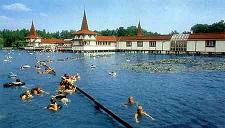
the bathing lake
KESZTHELY
Largest
settlement on the northern shore of Lake Balaton, aged centre for
holiday, foreign tourism, culture, and education. The territory has
been inhabited for 7000 years.The most outstanding sight is te Festetics
Mansion
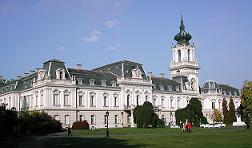
festetics mansion
(Kastély
u; 1754, Baroque; concerts in the mirror hal and the protected park;
Helikon Mansion Museum; Helikon Library: 80000 volumes, the largest
surviving aristocratic library); 18. c. Baroquebuildings stand in
Kastély str. Georgikon Farm Museum (Bercsényi str. 67; onetime grain
store: 1825). Kossuth str. is the city pedestrian precinct. Doll museum
(Bakacs str.; 500 porcelain dolls in the folk costumets of Hungary),
waxworks (ibid.). snail parliament (ibid); Pethő- or Goldmark House
(Kossuth str. 20 , 18. c.); birth house of composer Károly Goldmark;
synagogue (19. c)
Fő tér: R. C. parish church (1386, Gothic; inside: the largest Gothik
frescoes in the country: 15. c.; grevestone slab of the founder, platine
Laczkffy: 1397; Kristóf Festetics's Rococo tomb: 1765); in front of
the church, Neo-gothic tower (1878); Holy Triniti statue (Boroque);
Town Hall (ibid., 1769, Late Baroque); garden of ruins on the S side
of the church (circular Árpád period church and foundation walls of
Turkish period fortification).
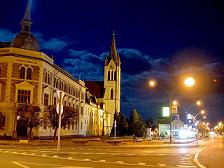
main squere
Balaton
Museum (Kossuth u.; Neo-baroque palace : 1928, Györgyi Dénes); Helikon
park , inside Helikon memorial; St Nicholas cemetery Festetics György
str. ; Festetics mausoleum, Neo-classical , 1924); Júlia Szendrey'
birth house (Szendrey settlement, to the south of the cemetery).
TAPOLCA
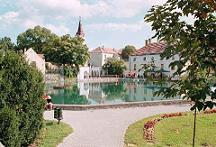
mill lake
Lake
Cave (Kisfaludy u. 3; a natural formation unique in Central Europe,
4 km long, protected; boating opportunities); St Borála's statue opposite
the entrance (2000:László Márton); R. C. parish church (Church Hill;
13.-15. c., Romanesque-Gothic; reconstuction: 1756, Baroque); alongside,
garden of ruins (foundations of roman and Árpád period buildings);
Town Museum (onetime choirmaster's house, 8 Church hill; ethnography,
local history and school history collection); opposite, parsonage
(Baroque); in front, statue of St John of Nepomuk; Tapolca pantheon
(by the smaller lake); opposite, Holy Weeel spring house (Baroque:
Inside, Erzsébet Udvardy's Madonna); bust of Gabriella Baumberg (1966:
András Kocsis): Malom-tó: by the shore, ancient colorful houses and
a onetime water mill (18th c.; now a hotel), next to the walkway,
statue of Janos Batsányi (1954, György Segesdy); permanent exhibitition
of sculptor László Márton (Batsányi tér 1.) St Antal Wine Museum (Arany
J. str. 1); Holy Trinity column (Fő tér; 1757); Old cemetery (grave
of poet Janos Batsányi and his wife Gabriella Baumberg).
Events: Tapolca Summer: Jul.-Aug.; Tapolca Festive Days: middle of
Aud.; Tapolca Evenings: once a month Sept.-May.
SZIGLIGET
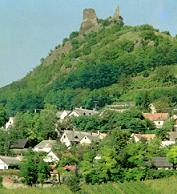
view of szigetvár
Old
village: around a church, in picturesque zigzag streets; around 120
protected buildings, 18th c.; R. C. church (of 18th c. origin; present
form: 1721);
castle ruins on the top Castle hill (13th-16th c.; finely restored
walls, towers, beautiful wiev); Esterhazy Cellar and Wine Museum (Kossuth
str. 3.); former Esterhazy Mansion (Nr. 17; 18th c. origin; present
form; early 19th c.; now: Writers' Creative House); park is NR; Lengyel
Manor (1982, Baroque; now a restaurant); István Farkas Memorial House
(Kamonkő u. .; watercolors by the artist); Avas church ruin (Réhelyi
u.; 13th c. ); craftmen's house; exhibition hall (Kisfaludy u.); ruins
of Óvár (on the Királyné Szoknyája hill).
Events: military games, concerts: in high seasons, at weekends; Szigliget
summer Days: beginning of Aug.; vintage procession and ball: end of
Sept.
SÜMEG
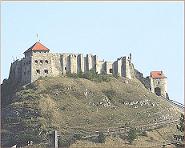
view of sumeg's castle
Evocative,
historic little town and place of pilgrimage, rich in monuments. Sümeg
castle, which crowns the castle hill, provides a picturesque sight.
A pleasant footpath leads up to the largest ruined castle in Transdanubia.
(Olsd tower: 13. c., other sections 15. -17. c.; Castle museum); Castle
stables (Vároldal str. 5. ; around 1750, Baroque; the Radetzky hussar
association is now stationed here; exhibitition; Gyöző Somogyi's graphics
on the histories of hussars, horse brasses); Carriage museum (next
to the castle inn; collection of carriages, cannon and sabres). Parrish
church of our Lord's ascension (Bíró M. u. 3.; 1756-1759, Baroque;
marvellous frescoes by F. A. Maulbertsch on the walls and celling);
Baroque and electric town houses (Kossuth str. 18.-19. c.) Kisfaludy
Museum (Nr. 3; 18th c. ; the poet was born here); in front sümeg pantheon
(memorial plaques to the famous sons of the town); Baroque country
houses (Szent István tér, Udvarbíró tér); Bishop's place (ibid.; 1745-1753,
Baroque; chapel decorated with stucco); Fransiscan church (ibid.;
1652-1657, early Baroque; Extended: 1724-1733; valuable altars, statues,
frescoes; miracle-working shrine statue of the Virgin Mary; pilgrimage
church); alongside, Franciscan monastery (1652, reconstructed: 1949);
town cemetery (here lie the poet Sándor Kisfaludy and his wife Róza
Szegedy)
Excursion: Prehistoric flint mine of mogyorós hill (geology exhibition;
approach: József Attila. str. and a short section of route 84)
Events: Castle games (tilting, jousting): all year; Radetzky Day:
May; Great pligrimage of the Heart of Jesus: Jun.-Aug.; Border Castle
Days: Aug.; Chief pilgrimage of the Virgin Mary: Aug,; Hussar-hunter
riding to close season: Nov.
 |
 |